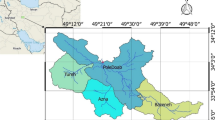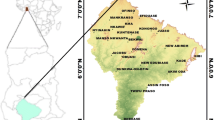Abstract
In this study, a Physiographic Soil Erosion–Deposition Model (PSED) is applied for better management of a watershed. The PSED model can effectively evaluate the key parameters of watershed management: surface runoff discharge, suspended sediment transport rate, quantity of soil erosion, and spatial distribution of soil erosion and deposition. A basin usually contains multiple watersheds. These watersheds may have complex topography and heterogeneous physiographic properties. The PSED model, containing a physiographic rainfall-runoff model and a basin scale erosion–deposition model, can simulate the physical mechanism of the entire erosion process based on a detailed calculation of bed-load transportation, surface soil entrainment, and the deposition mechanism. With the assistance of Geographic Information Systems (GIS), the PSED model can handle and analyze extremely large hydrologic and physiographic datasets and simulate the physical erosion process without the need for simplification. We verified the PSED model using three typhoon events and 40 rainfall events. The application of PSED to Chou-Shui River basin shows that the PSED model can accurately estimate discharge hydrographs, suspended sediment transport rates, and sediment yield. Additionally, we obtained reasonable quantities of soil erosion as well as the spatial distribution of soil erosion and deposition. The results show that the PSED model is capable of calculating spatially distributed soil erosion and suspended sediment transport rates for a basin with multiple watersheds even if these watersheds have complex topography and heterogeneous physiographic properties.




















Similar content being viewed by others
References
American Society of Civil Engineers 1975 Sedimentation Engineering; pp. 472–476.
ASTM Standards D3977 2007 Standard Test Methods for Determining Sediment Concentration in Water Samples; http://www.astm.org.
Beasley D B, Huggins L F and Monke E J 1980 Answers: A model for watershed planning; Trans. Am. Soc. Agric. Eng. 23 (4) 938–944.
Bhattarai R and Dutta D 2007 Estimation of soil erosion and sediment yield using GIS at catchment scale; Water Resour. Manag. 21 1635–1647.
Brazier R E, Beven K J, Freer J and Rowan J S 2000 Equifinality and uncertainty in physically-based soil erosion models: Application of the GLUE methodology to WEPP, the Water Erosion Prediction Project for sites in the UK and USA; Earth Surf. Proc. Land. 25 825–845.
Chen S C and Lai I C 1999 Estimating the sediment delivery ratio of the watershed; J. Chinese Soil Water Conserv. 30 (1) 47–57.
Chen C N, Tsai C H and Tsai C T 2004 A study of GIS linked physiographic soil erosion–deposition model for watershed; J. Chinese Institute Civil Hydraul. Eng. 16 (3) 379–391.
Chen C N, Tsai C H and Tsai C T 2006 Simulation of sediment yield from watershed by physiographic soil erosion–deposition model; J. Hydrol. 327 293–303.
Chen C N, Tsai C H and Tsai C T 2011 Simulation of runoff and suspended sediment transport rate in a basin with multiple watersheds; Water Resour. Manage. 25 793–816.
Chow V T, Maidment D R and Mays L W 1988 Applied Hydrology; McGraw-Hill: New York, pp. 153–155.
Edwards T K and Glysson G D 1999 Techniques of water resources investigations of the US Geological Survey: Chapter 2. Field Methods Measurement of Fluvial Sediment, Virginia, USA.
Fu G, Chen S and McCool D K 2006 Modeling the impacts of no-till practice on soil erosion and sediment yield with RUSLE, SEDD, and ArcView GIS; Soil Till Res. 85 38–49.
Hu S C, Lu J Y, Wu I Y and Chen T F 1995 Interrill erosion rates of high clay soils in Lien-Hua-Chi area; Bull. Taiwan Forestry Res. Inst. 10 (1) 33–40.
Itakura T and Kishi T 1980 Open channel flow with suspended sediments; J. Hydraul. Div. 106 (8) 1325– 1343.
Jain M K, Kothyari U C and Raju K G R 2005 GIS based distributed model for soil erosion and rate of sediment outflow from catchments; J. Hydraul. Eng. 131 (9) 755–769.
Knisel W G 1980 CREAMS: A field scale model for chemicals, runoff and erosion from agricultural management systems; USDA, Conservation Research Report 26.
Ma M M 1995 The rainfall characteristics and erosivity in central and northern areas of Taiwan; Master Thesis, Department of Civil Engineering; National Chung-Hsing University, Taiwan.
Misra R K and Rose C W 1990 Annual for use of program GUEST; Division of Australian Environmental Studies Report, Griffith University, Brisbane, Qld.
Morgan R P C, Quinton J N, Smith R E, Govers G, Poesen J W A, Auerswald K, Chisci G, Torri D and Styczen M E 1998 The European soil erosion model (EUROSEM): A process-based approach for predicting sediment transport from fields and small catchments; Earth Surf. Proc. Land. 23 527–544.
Murakami S, Hayashi S, Kameyama S and Watanabe M 2001 Fundamental study on sediment routing through forest and agricultural area in watershed; Ann. J. Hydraul. Eng. 45 799–804 (in Japanese).
Mutchler C K and Young R A 1975 Soil detachment by raindrops: In: Proceedings of Sediment-yield Workshop, ARS-S-40, USDA.
Nearing M A, Foster G R, Lane L J and Finkner S C 1989 A process-based soil erosion model for USDA – Water erosion prediction project technology; Trans. Am. Soc. Agric. Eng. 32 (5) 1587–1593.
Paringit E C and Nadaoka K 2003 Sediment yield modelling for small agricultural catchments: Land-cover parameterization based on remote sensing data analysis; Hydrol. Process. 17 1845–1866.
Renard K G, Foster G R, Weesies G A and Porter J P 1991 RUSLE, Revised Universal Soil Loss Equation; J. Soil Water Conserv. 16 (1) 30–33.
Ricker M C, Odhiambo B K and Church J M 2008 Spatial analysis of soil erosion and sediment fluxes: A paired watershed study of two Rappahannock river tributaries, Stafford County, Virginia; Environ. Manag. 41 766– 778.
Rose C W, Williams J R, Sander G C and Barry D A 1983 A mathematical model of soil erosion and deposition process I: Theory for a plane element; Soil Sci. Soc. Am. J. 47 991–995.
Sheh C S and Wang M K 1991 An atlas of major soils of Taiwan and a general map of soils in Taiwan (Scale 1: 250,000); Council of Agriculture, Taiwan.
Shimizu Y, Yamaguchi H and Itakura T 1990 Three-dimensional computation of flow and bed deformation; J. Hydraul. Div. 116 (9) 1090–1108.
Sun H, Cornish P S and Daniell T M 2002 Contour-based digital elevation modeling of watershed erosion and sedimentation: Erosion and sedimentation estimation tool (EROSET); Water Resourc. Res. 38 (11) 1–10.
Tsai C T and Tsai C H 1997 A study on the applicability of discharge formulas for trapezoidal broad-crested weirs; J. Taiwan Water Conserv. 45 (2) 29–45.
Wang Y M, Tfwala S S, Chan H C and Lin Y C 2013 The effects of sporadic torrential rainfall on suspended sediments; Archives Sci. 66 (5) 211–224.
Williams J R 1975 Sediment routing for agricultural watersheds; Water Resour. Bull. 11 965–974.
Williams J R, Jones C A and Dyke P T 1984 A modeling approach determining the relationship between erosion and soil productivity; Trans. Am. Soc. Agric. Eng. 27 129–144.
Wischmeier W H and Smith D D 1978 Predicting Rainfall Erosion Losses – A Guide to Conservation Planning; USDA, Agriculture Handbook No. 537: 58.
Wongsa S, Nakui T, Iwai M and Shimizu Y 2002 Runoff and sediment transport modeling for mountain river; In: Proceeding of River Flow 2002 – International Conference on Fluvial Hydraulic Belgium, pp. 683–691.
Wu C H, Chen C N, Tsai C H and Tsai C T 2012 Estimating sediment deposition volume in a reservoir using the physiographic soil erosion–deposition model; Int. J. Sedim. Res. 27 362–377.
Young R A, Onstad C A, Bosch D D and Andersen W P 1989 AGNPS: A nonpoint-source pollution model for evaluating agricultural watersheds; J. Soil Water Conserv. 44 168–173.
Yuan Z J, Cai Q G and Chu Y M 2007 A GIS-based distributed soil erosion model: A case study of typical watershed, Sichuan basin; Int. J. Sedim. 22 (2) 120–130.
Author information
Authors and Affiliations
Corresponding author
Rights and permissions
About this article
Cite this article
Lin, CP., Chen, CN., Wang, YM. et al. Spatial distribution of soil erosion and suspended sediment transport rate for Chou-Shui river basin. J Earth Syst Sci 123, 1517–1539 (2014). https://doi.org/10.1007/s12040-014-0484-2
Received:
Revised:
Accepted:
Published:
Issue Date:
DOI: https://doi.org/10.1007/s12040-014-0484-2




